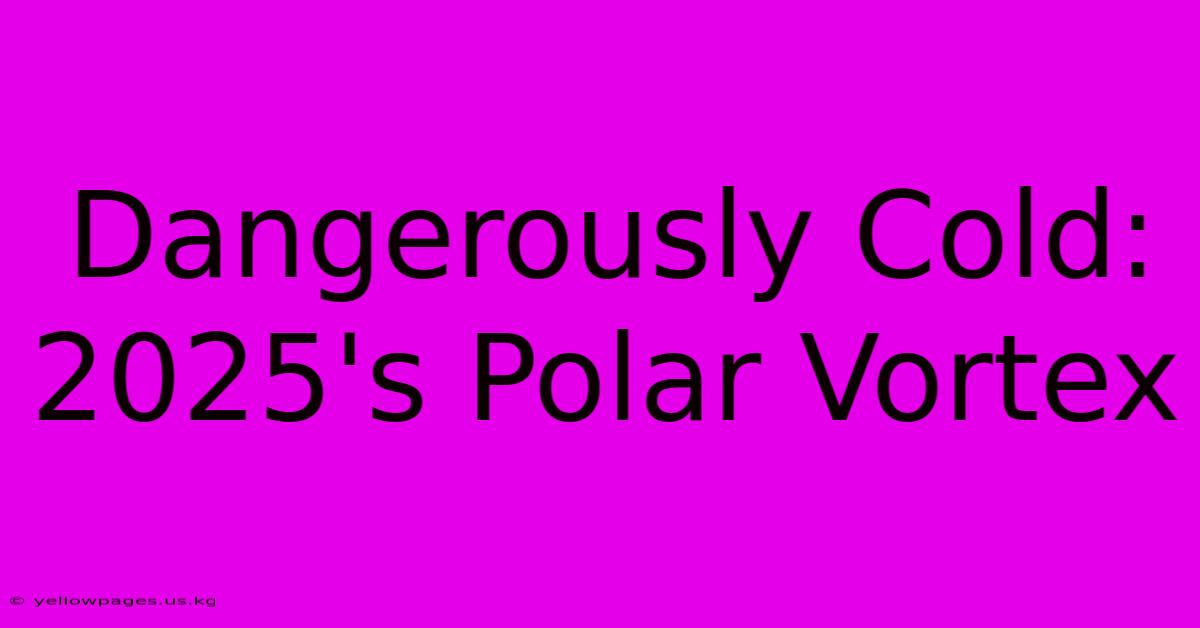Dangerously Cold: 2025's Polar Vortex

Discover more detailed and exciting information on our website. Click the link below to start your adventure: Visit Best Website trendingnews.us.kg. Don't miss out!
Table of Contents
Dangerously Cold: 2025's Polar Vortex – A Deep Dive into Extreme Weather
The year is 2025. News headlines scream about plummeting temperatures, record-breaking snowfall, and the devastating impact of a particularly vicious polar vortex. But what exactly is a polar vortex, and why is 2025's event shaping up to be so dangerous? This article delves into the science, the impacts, and what we can expect from these extreme weather events in the years to come.
Understanding the Polar Vortex
The polar vortex isn't a singular, easily defined entity. Instead, it's a large area of low pressure and cold air surrounding both of the Earth's poles. These swirling masses of frigid air are a naturally occurring phenomenon, existing year-round in the stratosphere and troposphere. However, their behavior can fluctuate dramatically, leading to periods of significant instability.
What Causes Vortex Disruptions?
The strength and stability of the polar vortex are influenced by several factors, including:
- Temperature Gradients: A strong temperature difference between the polar regions and lower latitudes helps maintain a stable vortex. Weakening of this gradient can lead to instability.
- Stratospheric Warming Events: Sudden stratospheric warming events (SSWs) can disrupt the polar vortex, causing it to weaken or even split into multiple parts. These events are becoming increasingly frequent, potentially linked to climate change.
- Wave Propagation: Waves in the atmosphere, known as Rossby waves, can propagate from lower latitudes and interact with the polar vortex, influencing its behavior.
The 2025 Polar Vortex: An Unprecedented Event?
While we can't definitively predict the exact severity of the 2025 polar vortex event (as it's hypothetical), the current trend towards more frequent and intense SSWs suggests the potential for a significant disruption. This could lead to:
- Prolonged periods of dangerously cold temperatures: Think sub-zero temperatures lasting for weeks, impacting infrastructure and public health.
- Increased snowfall and blizzards: Heavy snowfall could overwhelm transportation networks and cause widespread power outages.
- Significant economic disruption: The impacts on transportation, agriculture, and energy supply could lead to considerable economic losses.
The Impacts of Extreme Cold
The consequences of a powerful polar vortex are far-reaching and can impact numerous aspects of life:
Public Health
- Hypothermia and frostbite: Extreme cold significantly increases the risk of these life-threatening conditions.
- Increased respiratory illnesses: Cold weather can exacerbate existing respiratory conditions and increase the incidence of new ones.
- Increased mortality: Studies have shown a direct correlation between cold snaps and increased mortality rates.
Infrastructure
- Power outages: Heavy snowfall and ice can damage power lines and lead to widespread outages.
- Transportation disruptions: Snow and ice can make roads and airports impassable, halting transportation networks.
- Water pipe bursts: Freezing temperatures can cause water pipes to burst, leading to flooding and property damage.
Agriculture
- Crop damage: Extreme cold can severely damage crops, leading to reduced yields and food shortages.
- Livestock losses: Farmers may lose livestock due to exposure to extreme cold.
Preparing for the 2025 Polar Vortex and Beyond
While predicting the precise details of future polar vortex events remains challenging, preparing for the possibility of extreme cold is crucial. Individuals, communities, and governments need to take proactive steps, including:
- Investing in weather-resistant infrastructure: Improving the resilience of power grids and transportation networks is paramount.
- Developing early warning systems: Effective communication of weather warnings is essential to allow for timely preparation.
- Public education campaigns: Raising public awareness about the risks of extreme cold and promoting preparedness measures is crucial.
- Community support networks: Establishing support networks to assist vulnerable populations during cold snaps is vital.
The 2025 polar vortex serves as a hypothetical case study highlighting the increasingly significant threat posed by extreme weather events. Understanding the science behind these events and investing in preparedness measures is crucial for mitigating their devastating impacts. The future of weather prediction and adaptation will play a vital role in our ability to safeguard communities and infrastructure from the dangers of a dangerously cold future.

Thank you for visiting our website wich cover about Dangerously Cold: 2025's Polar Vortex. We hope the information provided has been useful to you. Feel free to contact us if you have any questions or need further assistance. See you next time and dont miss to bookmark.
Featured Posts
-
Puerto Rico Faces Widespread Blackouts
Jan 01, 2025
-
Widespread Outages Darken Puerto Rico
Jan 01, 2025
-
Wrigley Field Hosts Bedard In 2025
Jan 01, 2025
-
Relia Quest Bowl Live Game Blog Alabama Vs Michigan
Jan 01, 2025
-
Illinois Valentine Injured Vs South Carolina
Jan 01, 2025
